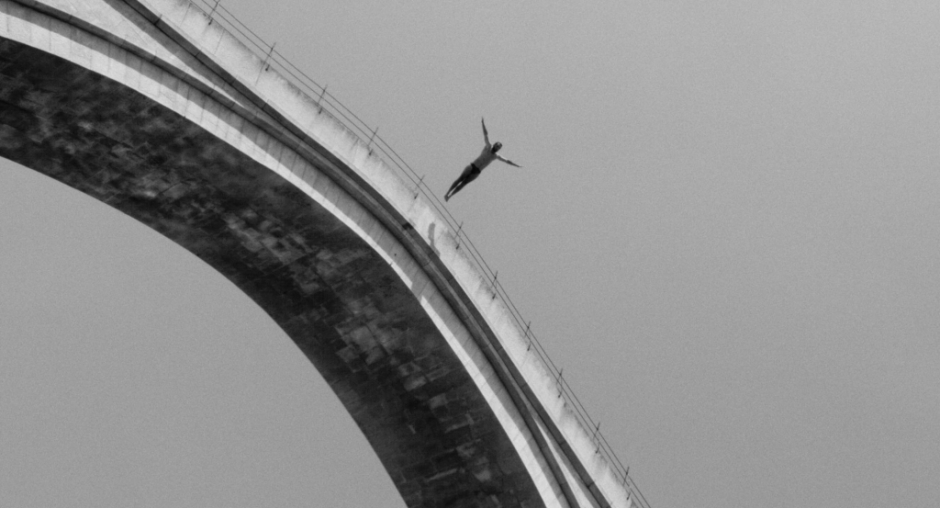Stills from ‘Araf’, courtesy of artist, 2018.
Araf | Berlinale Film Festival | Forum Expanded
For the 13th year of its running, the Forum Expanded of Berlinale (14-26 February) took the title ‘A Mechanism Capable of Changing itself’, inviting expressions and explorations from documentary filmmakers of the specific agency of cinema. The curatorial team consisted of section director Stefanie Schulte Strathaus, filmmaker Khaled Abdulwahed, curator Ulrich Ziemons, artist/curator Maha Maamoun and Anselm Franke (Haus der Kulturen der Welt) who was involved in a consulting capacity.
One of the films in Forum Expanded which responded to cinema’s capacity to explore its own agency through form was Araf by Didem Pekün. Araf describes itself as an ‘essayistic road movie’ which follows the journey of a woman who, having fled the country during the war, returns to her homeland of Bosnia for the 22nd memorial of the Srebrenica genocide. Its central motif is the annual diving competition that takes place on Mostar bridge, where the winner is awarded the title of Icarus, a tradition dating back several hundred years. The story of Icarus, a Greek mythical figure who flew too close to the sun, melting his wings and thus falling to his death, gives the film its symbolic foundation. In the scenes depicting Mostar bridge, the camera moves from the lone diver on the bridge to the people sitting below, some looking up to watch, others involved in their own world, enjoying the cold water on a hot day. Their indifference recalls another poetic Icarus, that of W.H. Auden’s ‘Musée des Beaux Arts’, where the poet notes ‘how everything turns away / Quite leisurely from the disaster’. Araf traverses similar territory to Auden, who was writing in 1938 in a Europe on the eve of war. The film, like the poem, reaches for historical specificity but seeks also to locate itself in a more expansive, mythical spaceö which moves beyond historical record. In that sense, Araf creates a portrait finely balanced between the particular and the universal. It withholds information about the protagonist-narrator Nayia, the woman from whose perspective we see the film. Her status as unseen and mysterious observer creates a more omniscient voice, allowing her words to resonate with other scenes of ethnic cleansing, with other people who must inhabit the turmoil of exile.

The commingling of beauty and horror is woven throughout the film. Lingering shots of the diver’s body enable an appreciation of his strength and grace, but show them to us in fragments – a shot of his legs mounting the rail, another of the rippling of shoulder muscle as he stretches, recall the dispersal of body parts after the Srebrenica genocide. The narrator tells us of that fact; those searching for the unmarked graves of victims follow a trail of blue butterflies who eat from a special fungi growing from the burial sites. That image of beauty feeding off unspeakable horror is particularly apt for the film’s own unsettling juxtapositions and its concern with the relation of the aesthetic to the political, of art to suffering.
The film’s delicacy lies in the tautness of the contradictory energies at work and the notion of ‘araf’ (the Turkish word for limbo, or purgatory) is manifested throughout. Always alert to the sensory experiences of the viewer, its visual and sonic patterns are quietly perturbing, the simplicity of the images belying a highly-crafted work. It is both gentle and jarring, serene and perplexing; the sinuous curves of roads and railways disrupted by sharp transitions in speed, sound and thematic mode. These oppositions are what wins the film a lyric intensity that sustains its questing ethical imperative. The sudden shifts in pacing and perspective disable any complacent enjoyment of the beautiful shots. One moment sound is muffled and heard at a distance, as if through thick windows, the next, we are plunged back into the noise of city streets. In slow-motion shots, we are driven along a road at night watching the car ahead move as if in suspended animation, before switching to real-time speeds. Despite the softness of the black-and-white film, we sense the fierce shimmer of the heat as pilgrims to the Srebrenica memorial-graveyard mourn their loved ones. These contrasts in sensory perception perform the disorientation and alienation of the narrator as well as heightening our own sense of being caught up in this purgatorial condition she inhabits.

One thing that the film withholds from us is an experience of completion, whether by focusing on parts of an image rather than the whole (as in the shots of the diver’s body) or by avoiding narrative completion of scenes. While we see cars and trains in motion, they never arrive at a destination; instead, these scenes cut to panoramic city shots. This dynamic plays out most intensely at the end of the film, where we see the diver plunge from the bridge for the last time. By moving us through several shots taken at different angles, the dive is prolonged: seconds extend to what seems minutes as we wait with trepidation for the moment of impact. But that moment never comes, leaving us with the final image of the diver’s shadow flitting across the surface of the water, as if a bird were soaring on its way above the river, upwards towards the sun. That ambiguity, and its accompanying sense of narrative irresolution (does he complete the dive safely, elegantly?) lends further weight to the final question posed by the narrator: ‘how will each Daedalus flee, and how will every Icarus land?’
Araf can be viewed at Geometries, an exhibition curated by locus athens http://locusathens.com/lcu/geometries/ from March 27, 2017.
by Dr. Clara Dawson

